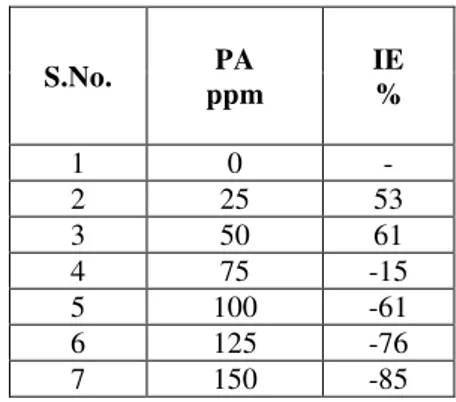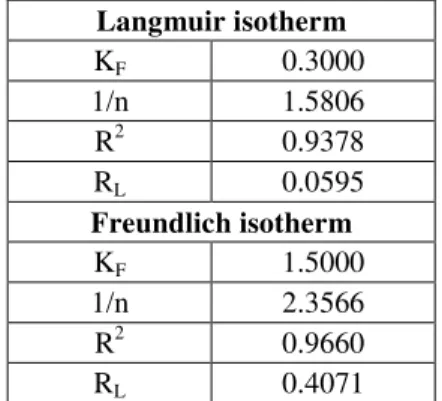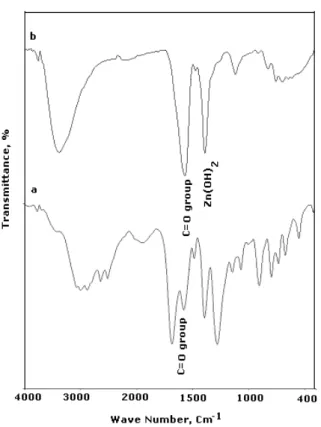Corrosion Inhibition by
–
Phthalic Acid - Zn
2+System
R. Mohan
1,
S.K. Selvaraj
2, Sakthivel
3,
A. John Amalraj
4, J. Wilson Sahayaraj
5,
A. Peter Pascal Regis
6, C. Rajarathinam
6, And
G. Dhananjayan
41
Department of Chemistry, Surya Polytechnic College, Villupuram - 605652, Tamil Nadu, India. 2
PG and Research Department of Chemistry, GTN Arts College, Dindigul-624 005, Tamil Nadu, India. 3
Tamil Nadu Pollution control Board, Dindigul-624003, Tamil Nadu, India. 4
PG and Research Department of Chemistry, Periyar E.V.R college (Autonomous), Trichy - 620023, Tamil Nadu, India.
5
Department of Chemistry, Jeppiaar Engineering College, Chennai- 600119, Tamil Nadu, India.
6PG and Research Department of Chemistry, St.Joseph’s College (Autonomous), Trichy
- 620002, Tamil Nadu, India.
ABSTRACT
The inhibition effect of Phthalic acid(PA) – Zn2+ system controls the corrosion of carbon steel has been studied by weight – loss method. The weight – loss study reveals that the formulation consisting of 60 ppm of Zn2+, 50 ppm of phthalic acid has 82 % inhibition efficiency. Synergistic effect exists between phthalic acid- Zn2+ system. The influence of N-cetyl- N, N, N-trimethylammonium bromide(CTAB) on the PA- Zn2+ system control the microbial corrosion. The value of the separation factor, RL indicated the phthalic acid- Zn2+ system was favorable adsorption. The Adsorption equilibrium exhibited better fit to Langmuir isotherm than Freundlich isotherm. The protective film consists of Fe2+ - Phthalic acid and Zn(OH)2 by FTIR spectroscopy.
Key Words
: Corrosion inhibition efficiency, Phthalic acid, Protective film, adsorption isotherm;I.
INTRODUCTION
Corrosion is the loss of useful properties of a material as a result of chemical or electrochemical reaction with its environment. . The consequences of corrosion are quite many and are considered a serious problem in industry, constructions and civil services such as electricity, water and sewage systems. To prevent or minimize internal corrosion in these systems, inhibitors are used especially in flow and closed systems, such as fresh water distribution systems. A corrosion inhibitor is a substance which when added in small concentration to an environment, effectively reduces the corrosion rate of a metal exposed to it. The organic compounds and several carboxylates such as sodium salicylate, sodium cinnamate and adipate have been used as inhibitors[1-5]. Reviews of carboxylates as corrosion inhibitors have appeared from time to time. More detailed studies of particular carboxylates have also been published. Corrosion of tin in citric acid solution and effect of some inorganic anion have been studied[6]. Synergistic effect of succinic acid and Zn2+ in controlling corrosion of carbon steel in well water has been reported[7]. The corrosion inhibition of carbon steel by sodium potassium tartrate has been studied by Arockia selvi et al.[8] Florence et al. have investigated the corrosion inhibition of carbon steel by adipic acid[9]. The inhibition efficiency of sodium potassium tartarate in
controlling corrosion of stainless steel in sea water has been studied by Wilson et al[10].The present work is undertaken:
1. To evaluate the inhibition efficiency (IE) of phthalic acid (PA) in controlling the corrosion of carbon steel in the absence and presence of Zn2+ 2. To analysis the protective film formed on the
carbon steel by FTIR spectra.
3. To analysis the protective film formed on the carbon steel by Langmuir and Freundlich isotherm
4. To propose a suitable mechanism for corrosion inhibition.
II.
EXPRIMENTAL
II.1. Preparation of the specimen
Carbon steel (0.026%S, 0.06%P, 0.4%Mn, 0.1% C, and the rest Fe) specimen of dimension 1 cm x 4 cm x 0.2 cm were used for weight loss study. Carbon steel rod of the same composition, encapsulated in Teflon was polished to a mirror finish and degreased with trichloroethylene.
II.2. Weight loss method
Carbon steel specimens in triplicate were immersed in 100 ml of distilled water containing various concentrations of the inhibitors, in the absence and presence of and Zn2+ ions, for a period of one day. The weight of the specimens before and
after immersion was determined using Shimadzu balance, AY62 model. The corrosion products were cleansed with Clarke’s solution[11]. From the change in weight of the specimens, corrosion rates were calculated with the help of the following relationship:
where
CR - corrosion rate Δm - loss in weight (mg)
A - surface area of the specimen (dm2) t - period of immersion (days)]
The inhibition efficiency (IE) was then calculated using the equation
Where W1 and W2 are the corrosion rates in the absence and presence of the inhibitor, respectively.
II.3. Surface examination
The carbon steel specimens were immersed in various test solutions for a period of one day, taken out and dried. The nature of the film formed on the surface of metal specimens was analyzed by FTIR spectroscopic and adsorption studies.
II.4. Surface coverage area 1/θ = θ/1-θ, 1/C-θ
C/θ = C/1-θ/θ.B
Where, θ =surface coverage area of metal ion solution at equilibrium,
C = equilibrium concentration of the metal ion, 1-θ = rate of adsorption,
B = constant related to the energy of adsorption.
II.4.1. Langmuir Adsorption isotherm model The Langmuir model was developed based on assumption of the formation of a monolayer of the metal ion solution onto the surface of the phthalic acid, It has also been assumed that surface sites are completely heterogeneous. The study of Langmuir isotherm is essential in assessing the adsorption efficiency of the phthalic acid. In this regard the Langmuir isotherm is important, through the restriction and the limitation if this model has been well recognized.
II.4.2. Freundlich Adsorption isotherm Model The Freundlich isotherm is the earliest known relationship describing the sorption equation. The fairly satisfactory empirical isotherm can be used for non-ideal sorption that involves heterogeneous surface energy system and is expressed by the following equation
IE = KFPA1/n
Where KF is roughly an indicator of the adsorption capacity and 1/n is the adsorption intensity. The essential characteristics of Langmuir and freundlich isotherm can be expressed in terms of dimension less constant, separate ion factor or equilibrium parameter RL, which is defined by RL = Co / 1+bCo is the initial metal ion concentration and b is the Langmuir constant the parameter indicates the shape of isotherm as follows.
RL Types of isotherm RL > 1 Unfavorable RL =1 Linear 0< RL < 1 Favorable RL = 0 Irreversible
The applicability of Langmuir and Freundlich model to then chosen metal ion solution system was studied in the present work.
II.5. FTIR spectra
FTIR spectra were recorded in a Perkin – Elmer 1600 spectrophotometer. The film was carefully removed, mixed thoroughly with KBr made in to pellets and FTIR spectra were recorded.
III.
RESULTS
AND
DISCUSSION
III.1. Analysis of Results of Mass Loss MethodThe inhibition efficiency(IE)of carbon steel immersed in aqueous medium for one day in the absence and presence of inhibitor at various concentration has been measured by weight loss study[12-14]. The corrosion inhibition efficiency of phthalic acid alone is given in the Table 1. It is found that the inhibition efficiency is decreases the concentration of phthalic acid increases. For example 50 ppm of phthalic acid shows 61% of IE, but 150ppm of phthalic acid accelerate the corrosion. The inhibition efficiency of Zn2+ alone in the system shows some IE (Table 2).
Table 1. Corrosion inhibition efficiency (IE) of carbon steels in presence of inhibitors obtained by weight loss method.
Inhibitor system : PA alone.
The IE of PA-Zn2+ system are given in the Table 3-4. From the above results to note that a
S.No. PA
ppm
IE %
1 0 -
2 25 53
3 50 61
4 75 -15 5 100 -61 6 125 -76 7 150 -85 (1)
* m CR
A t
2
100 1 (2)
1 W IE
W
synergistic effect exists between PA-Zn2+.For example, 50ppm of PA has 75% of IE, 60 ppm of Zn2+ has 43% of IE. However, the formulation consisting of 50 ppm of PA and 60 ppm of Zn2+ has 82% IE. That is mixture of inhibitions shows better inhibition efficiency than the individual inhibitors. Table 2. Corrosion inhibition efficiency (IE) of carbon steels in presence of inhibitors obtained by weight loss method.
Inhibitor system : Zn2+ alone
Table 3. Corrosion inhibition efficiency (IE) of carbon steels in presence of inhibitors obtained by weight loss method.
Inhibitor system : PA - Zn2+ system
Table 4. Corrosion inhibition efficiency (IE) of carbon steels in presence of inhibitors obtained by weight loss method.
Inhibitor system : PA - Zn2+ system
III.2. Influence of CTAB on the IE of PA-Zn2+ system
The biocide CTAB control the microbial corrosion caused by micro organism. It is observed from Table 5 that as the concentration of CTAB increases, the IE decreases and increases. A micelle would have been formed at the minimum efficiency concentration.
Table 5. Corrosion inhibition efficiency (IE) of carbon steels in presence of inhibitors obtained by weight loss method.
Inhibitor system : PA - Zn2+ -CTAB system
III.3. Langmuir adsorption isotherm Model The Langmuir adsorption model is based on the assumption that maximum adsorption corresponds to the saturated monolayer of Langmuir equation can be described by
C/θ = 1/θ.B + (1/θ)
Where C is the equilibrium concentration of the metal ion solution, θ is the surface coverage area of the metal ion, B is the Langmuir constant related to adsorption capacity and rate of adsorption, respectively. The linear plot of specific adsorption C/θ against the equilibrium concentration (C) Figure 1. Shows that the adsorptions obey the Langmuir model. The Langmuir constant B were determined from the slope and intercept of the plot and are presented in Table 6. The R2 values (0.9378) suggest that the Langmuir isotherm provides a good fit to the isotherm data
Figure 1.Langmuir isotherm for Zn2+ Solution on to Phthalic acid
S.No. Zn
2+
ppm
IE %
1 0 -
2 10 -47 3 20 -30
4 30 27
5 40 32
6 50 40
7 60 43
S.No. PA
ppm
Zn2+ ppm
IE %
1 0 0 -
2 25 30 75
3 50 30 75
4 75 30 55
5 100 30 53 6 125 30 36 7 150 30 40
S.No. PA
ppm
Zn2+ ppm
IE %
1 0 0 -
2 50 10 35
3 50 20 37
4 50 30 54
5 50 40 61
6 50 50 69
7 50 60 82
S.No. PA ppm
Zn2+ (ppm)
CTAB ppm
IE %
1 0 - - -
The essential characteristics if the Langmuir isotherm can be expressed in terms of a dimensionless constant separation factor RL given by the equation
RL = 1/1+bco
Where C0 is the highest initial concentration of phthalic acid and b is Langmuir constant. The parameter RL, indicates the nature of shape of isotherm accordingly.
Table 6. Langmuir Isotherm for Zn2+ Solution on phthalic acid
III.4. Freundlich adsorption isotherm Model The Freundlich isotherm (Table 6) is the earliest known relationship describing the sorption equation.
Table 6.Freundlich isotherm for Zn2+ solution on phthalic acid
The fairly satisfactory empirical isotherm can be used for non-ideal sorption that involves heterogeneous surface energy system and is expressed by the following equation
IE = KFPA 1/n
Where KF is roughly an indicator of the adsorption capacity and 1/n is the adsorption intensity. In general as the KF value increases the adsorption capacity of phthalic aicd. Value n>1 represent favourable adsorption condition [15]. The Linear form of equation is given below
log IE% = log KF + (1/n) log PA
Values of KF and n are calculated from the intercept and slope of the plot Figure 4. and are listed in Table 7. The R2 value (0.9660) is lower than Langmuir isotherm.
Figure 2.Freundlich isotherm for Zn2+ Solution on to Phthalic acid
Table 7. Langmuir and Freundlich isotherm constant and correlation Co-efficient for Adsorption of Zn2+ Solution Concentration
Langmuir isotherm KF 0.3000 1/n 1.5806 R2 0.9378 RL 0.0595 Freundlich isotherm KF 1.5000 1/n 2.3566 R2 0.9660 RL 0.4071
The best equilibrium model is determined based linear square regression correlation co-efficient R2 from Figure 5, It was observed that the equilibrium sorption data were very best fit isotherm expression conform the monolayer coverage process of phthalic acid on to Zn2+.
III.5. Analysis of FTIR spectra
The FTIR spectrum of pure solid phthalic acid is shown in figure 3a. The peak at 1581 cm-1 corresponds to >C=O Stretching frequency.
FTIR spectrum of thin film formed on the metal surface, after the immersion in 60 ppm of Zn2+ and 50 ppm of PA in shown in figure 3b. The >C=O stretching frequency shifted from 1581 cm-1 to 1576 cm-1.This indicates that the oxygen atom of carbonyl group has coordinated with Fe2+-PA complex on the anodic sites of the metal surface. The peak at 1397 cm-1 due to the Zn (OH)2 formed on the cathodic sites. The FTIR spectrum confirmed that the protective film consist of Fe2+-PA complex and Zn (OH) 2 on the metal surface [16, 17].
Zn2+ ppm
PA
ppm ln C θ θ/1-θ ln θ/1-θ 60 50 2.315 0.35 0.538 -0.62 60 50 2.99 0.37 0.587 -0.53 60 50 3.40 0.54 1.174 0.16 60 50 3.69 0.61 1.564 0.47 60 50 3.91 0.69 2.226 0.80 60 50 4.09 0.82 4.556 1.52
Zn2+ (ppm)
PA ppm
IE
Figure 3. FTIR spectrum of various test solution (a) solid phthalic acid(PA)
(b) Film formed on carbon steel after immersion of test solution containing 60 ppm of Zn2+ + 50 ppm of PA
IV.
MECHANISM
The weight – loss study reveals that the formulation consisting of 60 ppm of Zn2+ and 50 ppm of phthalic acid has 82 % inhibition efficiency. The FTIR spectrum reveals that the protective film consist of Fe2+ - PA complex and Zn(OH)2.
In order to explain the above observations, the following mechanism of corrosion inhibition is proposed[18].
1. When the environment consisting of 60ppm of Zn2+ and 50 ppm of PA is prepared, there is a formation of Zn2+ -PA complex.
2. When Carbon steel is introduced in this solution there is diffusion of Zinc complex towards the metal surface.
3. On the metal surface Zinc complex is converted into iron complex on the anodic site.
Zn2 -PA+ Fe2+ Fe2+ - PA+ Zn2+ 4. The released Zn 2+ combined with OH- to form
Zn(OH)2 on the cathodic Sites. Zn2+ + 2OH- Zn(OH)2 5. Thus protective film consists of Fe2+ - PA and
Zn(OH)2.
V.
CONCLUSION
The present study leads to the following conclusions:
The formulation consisting of 60 ppm of Zn2+ and 50 ppwm of phthalic acid has 82 % inhibition efficiency.
The synergistic effect exists between phthalic acid– Zn2+ system;
The value of the separation factor RL, indicated the phthalic acid system was favourable adsorption.
FTIR spectra reveal that the protective film consists of Fe2+ - phthalic acid complex on the anodic sites of the metal surface and Zn(OH) 2 formed on the cathodic site of the metal surface.
VI.
ACKNOWLEDGEMENT
The Authors are thankful to their respective management for their help and encouragement.
REFERNCES
[1] K. S. Sudhish, K. S. Ashish, C. M. Lutendo, M. K. Mwadham, and E. E. Eno, Inhibitive effect of azorubine dye on the corrosion of mild steel in hydrochloric acid medium and synergistic iodide additive, International Journal of Electrochemical Science, 7, 2012, 5057–5068.
[2] M. Ajmal, A. S. Mideen, and M. A. Quraishi, 2-hydrazino-6-methyl-benzothiazole as an effective inhibitor for the corrosion of mild steel in acidic solutions, Corrosion Science, 36(1), 1994, 79–84.
[3] A.Y. Musa, A. B. Mohamad, A. A. H. Kadhum, M. S. Takriff, and L. T. Tien, Synergistic effect of potassium iodide with phthalazone on the corrosion inhibition of mild steel in 1.0M HCl, Corrosion Science, 53(11), 2011, 3672–3677.
[4] E. E. Ebenso, A. Hailemichael, S. A. Umoren, and I. B. Obot, Inhibition of mild steel corrosion in sulphuric acid using Alizarin yellow GG dye and synergistic iodide additive, International Journal of Electrochemical Science, 3, 2008, 1325– 1339.
[5] H. Baeza, M. Guzmán, P. Ortega, and L. Vera, Corrosion inhibition of copper in 0.5 M hydrochloric acid by 1,3,4-thiadiazole-2,5-dithiol, Journal of the Chilean Chemical Society, 48(3), 2003, 23–26.
[7] Felicia Rajammal Selvarani, S. Santhamadharasai, J. Wilson Sahayaraj, A. John Amalraj and S. Rajendran, Synergistic effect of succinic acid and Zn2+ in controlling corrosion of carbon steel, Bulletin of Electrochemistry, 20, 2004, 561 – 565.
[8] J. Arockia selvi, S. Rajendran and A.J. Amalraj, Corrosion inhibition by sodium potassium tartrate-Zn2+ system for carbon steel in rain water collected from roof top, Indian Journal of Chemical Technology, 14, 2007, 382 – 388.
[9] G.R.H. Florence, A.N. Antony, J.W. Sahayaraj, A.J. Amalraj and S. Rajendran, Corrosion inhibition of carbon steel by adipic acid-Zn2+ system, Indian Journal of Chemical Technology, 12, 2005, 472-478. [10] J. Wilson sahayaraj, P. Reymond, S.
Rajendran and A. John Amalraj, Tartrate-Zn2+ system as corrosion inhibitor for stainless steel in sea water, Journal of Electrochemistry Society of India, 56, 2007, 14-19.
[11] G. Wranglen, Introduction to Corrosion and Protection of Metals (London, U.K:Chapman and Hall), 1985, 236. [12] V. Johnsirani, J. Sathiyabama, Susai
Rajendran and R. Nagalakshmi, “Corrosion inhibition by an aqueous extract of curcumin dye for carbon steel in sea water”, European chemical bulletin, 2(6), 2013, 401-406. [13] Susai Rajendran, K. Duraiselvi, P.
Prabhakar, M. Pandiarajan, M. Tamilmalar and R. Joseph Rathish, Corrosion resistance of commercial aluminium in simulated concrete pore solution in presence of curcumin extract, European Chemical. Bulletin, 2(11), 2013, 850-854.
[14] Eno E. Ebenso1, Ime B. Obot and L. C. Murulana, Quinoline and its Derivatives as Effective Corrosion Inhibitors for Mild Steel in Acidic Medium, International Journal of Electrochemical Science, 5, 2010, 1574 – 1586.
[15] I. Zaafarany and M. Abdallah, Ethoxylated fatty amide as corrosion inhibitors for carbon steel in hydrochloric acid solution, , International Journal of Electrochemical Science, 5, 2010, 18-28.
[16] K. Nakamoto, Infrared and Raman Spectra of Inorganic and Coordination Compounds, Wiley and Sons, New York, 4th edition, 1986, 95.
[17] R.M. Silverstein, G.C. Bassler and T.C. Morril Spectrometric Identification of
Organic compounds, John Wiley and Sons, New York , 1986, 72.



